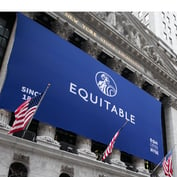What You Need to Know
- Depressing news may increase client interest in annuities and other products designed to protect principal.
- Bond rates are still high, and that should continue to support relatively high annuity crediting rates.
- Clients are still aging. They will need financial tools to deal with that.
This is the first in a new series of columns about annuities and retirement planning.
The rain keeps coming, the international news headlines look grim, and life and annuity market trackers say we’ll get through this.
Holding fast to a bright vision of the future is important, because optimism is as critical to retirement planning as calcium is to bones. Hope makes clients’ annuities hum and, ultimately, makes ordinary diversified portfolios sing.
Analysts at places like Fitch, PGIM, KPMG and Capgemini’s research arm are now out with commentaries and reports full of support for the proposition that, in spite of the clouds, your clients’ annuity providers are well-postioned to overcome bumps in the near term, should operate in a reasonably stable environment in the medium term, and should benefit from rising client longevity, affluence and sophistication over the long term.
Why dare hope annuity issuers and their clients will continue to prosper in the near term, with geopolitical tensions running so high?
One reason is that grim news can increase client demand for annuities and other products that appeal to risk-averse investors.
What’s really been happening to the market will start to emerge Oct. 25, when Ameriprise Financial becomes the first annuity issuer to post results for the third quarter. But American Equity, a midsize player, gave investors a hint last week, in its earnings release date announcement: It informed investors that its annuity sales for the quarter amounted to $2.2 billion, up 203% from the total for the year-earlier quarter.
And that was before the Middle East heated up, when survey data from the American Association of Individual Investors investor sentiment showed that investors were recovering from the post-Ukraine invasion blahs and starting to look about as bullish as in 2006.
Another reason for near-term hope is that the yield on the 10-year U.S. Treasury note is now hovering around 5%, and is close to the highest rates recorded since around 2007.
Higher rates on long-term bonds increase the rates that annuity issuers earn on the investments supporting annuity obligations. That means the issuers can offer annuity holders higher crediting rates while increasing the profitability of their annuity operations.
Meanwhile, for now, at least, the underlying state of the U.S. economy appears to be so strong that investors are assuming that the Federal Reserve will try to keep interest rates high, in an effort to keep borrowing costs high and cool inflationary exuberance in the labor market and the retail sales market.
The Outlook
Insurance rating analysts continue to write about the possibility the some of the issuers of the bonds, mortgages and mortgage-backed securities in annuity issuers’ portfolios could go bad, but the analysts are having trouble seeing how defaults could do much damage to big life and annuity issuers.
Fitch Ratings, for example, acknowledged earlier this month that U.S. life insurers rely heavily on private credit investments, and the rising interest rates and a weaker economy could hit private credit borrowers harder than they would hit issuers of investment-grade public corporate bonds.
“But we do not expect U.S. life insurers to face widespread downward rating pressure,” the analysts write. “For most insurers, allocations to private credit remains smaller in proportion to other asset classes, which mitigates the overall rating effects.”
So, there’s reason to have hope for 2024. What about the next two or three years?
CEOs think the next three years should be fine.
KPMG recently surveyed 1,325 of the world’s CEOs, including about 400 U.S. CEOs.









 October 25, 2023 at 04:24 PM
October 25, 2023 at 04:24 PM











